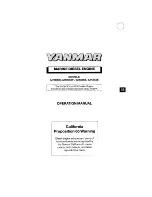
Jabiru Aircraft
Pty Ltd
Instruction & Maintenance Manual
Jabiru 2200 Aircraft Engine
Hydraulic Valve Lifter Models
This document is controlled while it remains on the Jabiru server. Once this no longer applies the document becomes uncontrolled.
REVISION
0
1
2
3
4
5
6 7
8
9
Dated : June 2010
Issued By: DPS
Page: 26 of 116
L:\files\Manuals_For_Products\Engine_Manuals\Transition\JEM2204-9_I&M_unsigned.docx
Perform a thorough pre-flight inspection.
Start and warm engine.
5.8.7
New Engine Storage
In many cases new or overhauled engines may be stored for some months or years
before being installed in an aircraft. All engines are treated with corrosion inhibitor by
Jabiru Aircraft Australia before shipping from the factory, however this treatment is
roughly equivalent to that described in Section 5.8.3 above. It is intended for a
maximum life of approximately 90 days
– though the exact effective life of the
treatment depends on the ambient temperature, humidity etc.
If an engine is to be stored before use the owner must:
i)
Install the engine within 90 days (nominally) of the engine leaving the factory, or
ii)
Repeat the Temporary Storage procedures given in Section 5.8.3 at a suitable
interval (90 days nominally, depending on ambient temperature, humidity etc)
and periodically inspect the engine in accordance with Section and 5.8.4, or
iii)
Treat and maintain the engine for Indefinite Storage per Section 5.8.5 above.
When the engine is to be run the storage measures must be reversed as detailed in
the appropriate sections above.
5.8.8
Operation in Winter
It is recommended to carry out an engine service prior to the start of the cold season.
For selection of oil, consult the table of lubricants given in the Engine Specifications
above. Follow the following advice for operation at extremely low temperatures:
5.8.9
Carburettor Icing
It is important to distinguish between two kinds of icing:
Icing due to water in fuel, and
i)
Icing due to high air humidity.
5.8.9.1
Icing Due to Water in fuel
Water in fuel will accumulate at the lower parts of the fuel system & can lead to freezing of
fuel lines, filters or jets. Remedies are:
a) Drain, using fuel tank water drain.
b) Ensure fuelling without traces of water. If in doubt, use a chamois as a filter.
c) Install a generously sized water separator.
d) Ensure that fuel lines do not permit the accumulation of water.
e) Add up to 2% isopropyl to fuel. Note: Addition of alcohol raises vapour pressure
and may aggravate vapour lock in warm weather; this practice should be used only
when needed and not in warm weather.
IMPORTANT
Fuels containing alcohol always carry a small amount of water in solution. In situations
where there are changes in temperature, or where there is an increase in alcohol content,
water (or a mixture of water & alcohol) may settle & could cause problems.
















































